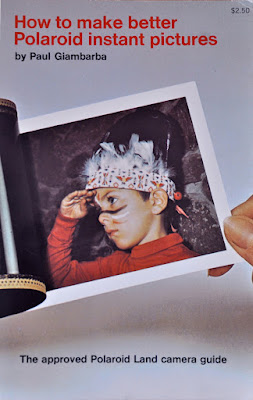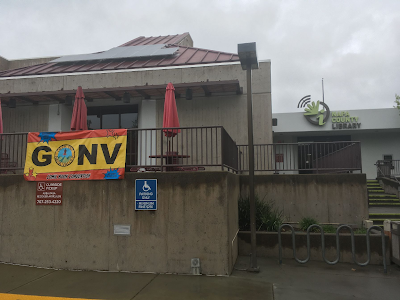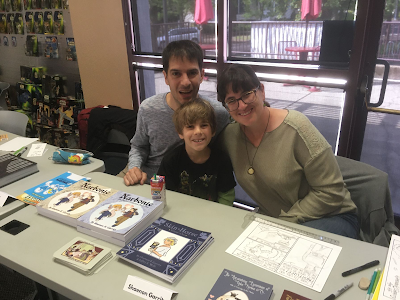Just a couple of days ago, I was extolling the virtues of a good obituary. Now I'm writing one, knowing it won't be good enough. I just learned from his son, Andy, that my friend Paul Giambarba died on Monday. He was 94.
I met Paul as a professional cartoonist on a private cartooning forum nearly 20 years ago. He had deeply personal experiences with cancer, including the death of his beloved first wife, Ruth, in 1978, and he thought I'd done a good job on Mom's Cancer. But cartooning was the least of Paul's talents and professions. He was a hugely influential graphic designer, author, editor, publisher, photographer, painter, printmaker, typographer, illustrator and more.
In 2006, Paul visited my hometown, where he had lived years before. We had a long lunch. Paul refused to take my money. We talked about art, careers, families, people he'd known and jobs he'd done. He was a great raconteur. I will always treasure that lunch, and we kept in touch afterward.
 |
| My lunch with Paul. |
I don't really know where to start with a life and talent so large, so I'll start with Polaroid.
Beginning in 1958, Paul was Polaroid's art director for 25 years. He designed the angular rainbow-striped graphics and packaging that looked terrific stacked on a shelf and instantly branded Polaroid as more exciting, youthful and modern than its stodgy yellow-and-black competitor, Kodak. Paul's campaign was a breathtaking success. Huge! Revolutionary! Decades later, Apple followed his playbook to persuade you that Apple computers were cooler, edgier and hipper than stuffy old PCs. If you believe that, thank (or blame) Paul because he did it first.
 |
| Paul Giambarba created that. If you're the right age, one look at those boxes really takes you back. |
 |
| Some of Paul's design sketches for Polaroid |
At the same time, Paul turned his photographer's eye to pushing the capabilities of the Polaroid camera--not a high-quality optical instrument by any measure--into something that could create art. While kids were snapping instant pics of each other at the beach, Paul figured out how to make the camera sing, and literally wrote the book teaching others how to make the most of it. If you ever see Polaroid prints hanging in galleries or museums, as I have, thank (or blame) Paul for that, too.
 |
| When I said "Paul literally wrote the book," I meant "literally" literally. That's his son Andy on the cover. |
Overlapping his Polaroid years, Paul and Ruth moved to Europe in 1955, an adventurous time to explore the Continent and an artistically fertile, inspirational period for Paul. With Ruth as his favorite model and muse, Paul pursued art and photography while embodying the best of Midcentury Modern graphic design in his work.
 |
| Ruth, 1959. |
 |
| Greeting card collage, 1969 |
 |
| A few years back, Paul offered some of his prints for sale. I always loved this graphic, done as a poster for a 1972 sailing regatta in Italy, and asked to buy a small print of it. Paul refused to take my money (again) and sent me this beautiful piece, which hangs on my wall. |
Following his Polaroid years, Paul was a design consultant for Tonka Toys and other corporate clients. As a cartoonist and illustrator, he was a regular contributor to
Sports Illustrated, This Week, True and
Spy magazines. Paul and his work were written up in many trade publications, and his list of awards from advertising, art direction, design, and graphic arts organizations is long.
Paul lived the last decades of his life on Cape Cod with his second wife, Fran. He told me that after traveling the world he felt the most at home there, and the region inspired him to do more art and write more books. Paul remained very active in what for other people might be retirement, and was remarkably open to new technologies and ideas. In particular, he embraced Photoshop--having spent most of his career doing paste-ups, layouts, color separations, typesetting, etc. the laborious, manual way--and, as he had with Polaroid half a century earlier, really pushed its capabilities to serve him instead of the other way around.
 |
| Fran and Paul in 2008, photographed in their home by my cartoonist pal Mike Lynch. |
 |
| Paul published many books of local interest through his own Scrimshaw Press. |
 |
| Scratchboard art. |
In more recent years, Paul enjoyed a well-deserved Renaissance of sorts, as Polaroid suddenly became hip again and people got very interested in the man who'd made it hip in the first place. Through a group called The Impossible Project, which set out to manufacture modern Polaroid film, he became the subject of documentaries and art exhibitions. The company even produced a special line of film named after him. It was a nice, graceful cap to a career he was rightly very proud of.
 |
| Have you ever in your life been this cool? Me neither. |
What a tremendous honor and privilege it was to know this man--a 5-and-a-half-foot giant from the Golden Age of illustration and design. I'm sad he's gone but Wow, what a life! How lucky he was to find two great loves in Ruth and Fran, enjoy a wonderful family, and be celebrated for a career doing what he loved.
Here are more examples of his expansive work, mostly nicked (as are many of the images above) from Paul's blogs and portfolios. What a gift.
 |
| Watercolor, Montauk Lighthouse |
 |
| Watercolor. Look how he painted the smoke from that boat! Simple but elegant design work. |
 |
| Kenneth Starr, Bill Clinton, Monica Lewinsky |
 |
| Paul McCartney and Heather Mills |
 |
| Donald Rumsfeld |
 |
| Collage. The cover to a Spanish textbook. |
 |
| A cartoon I don't know much about but think is great in its characterization and detail. |














































